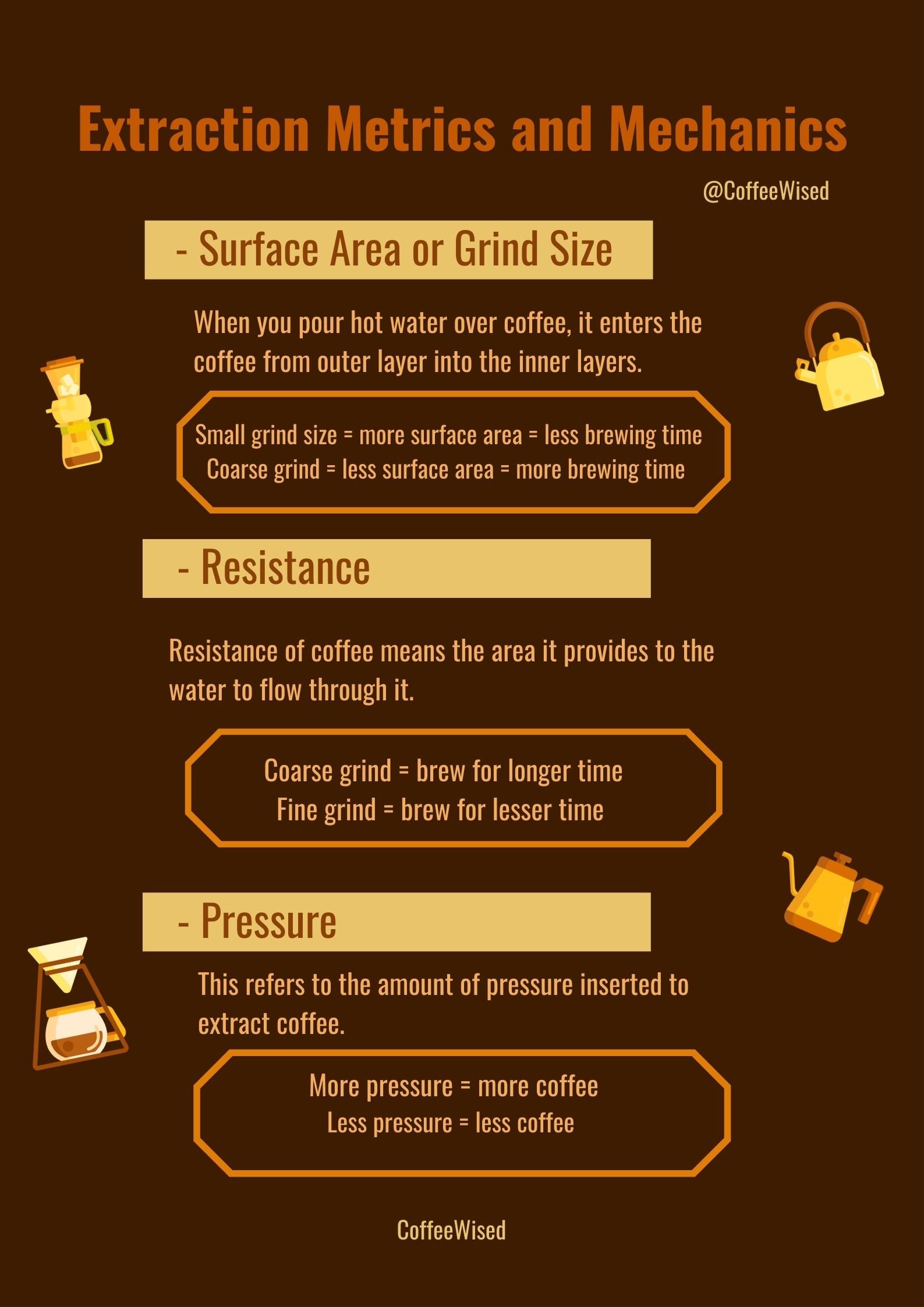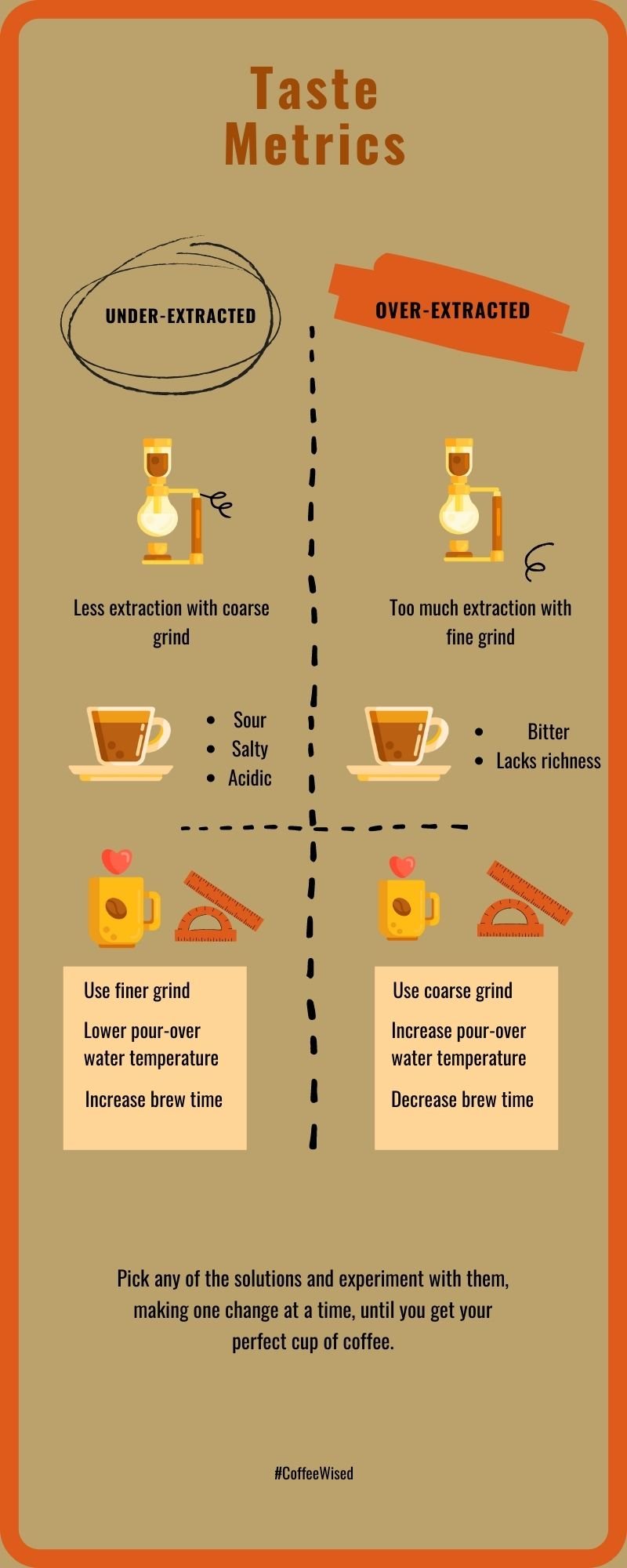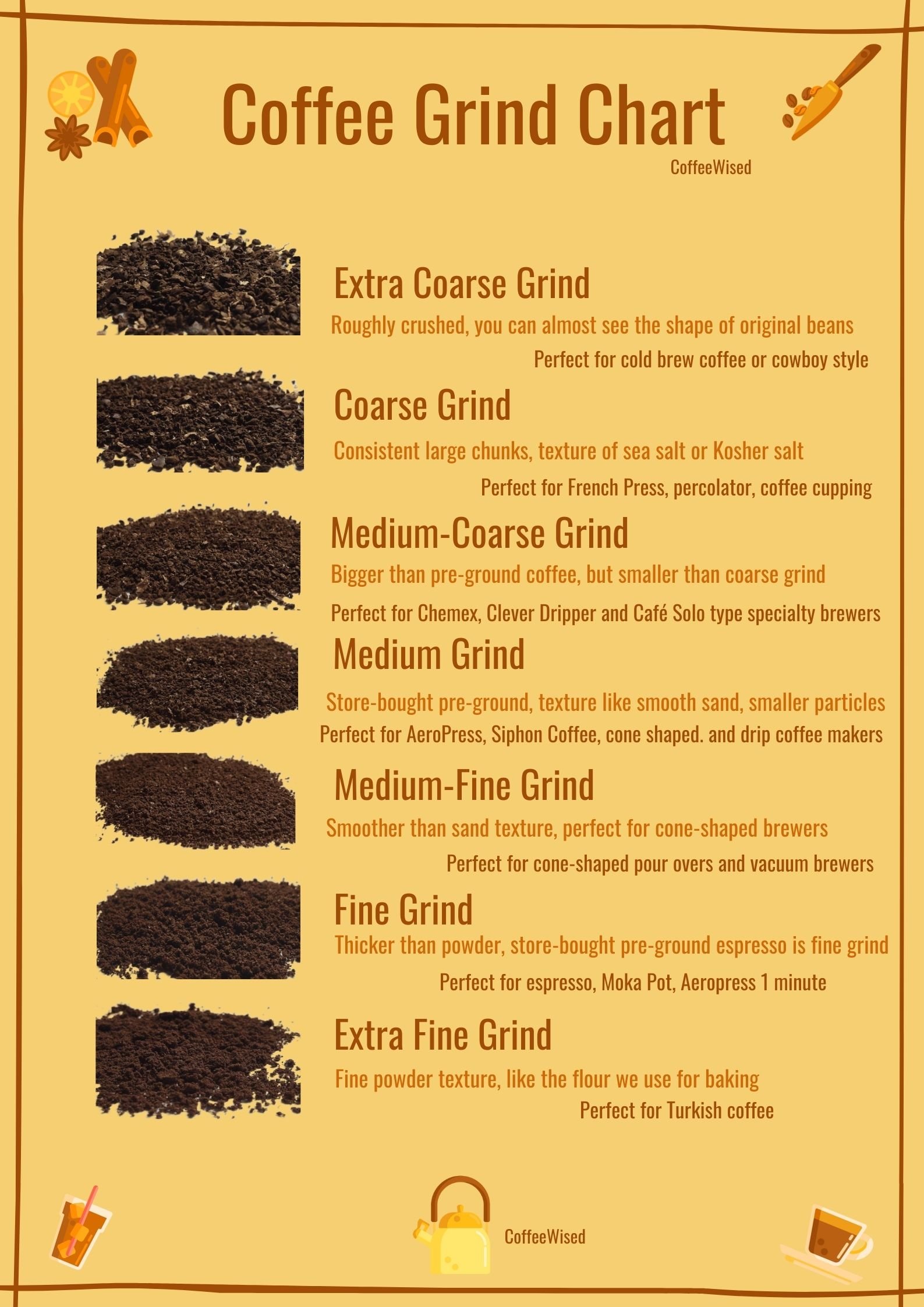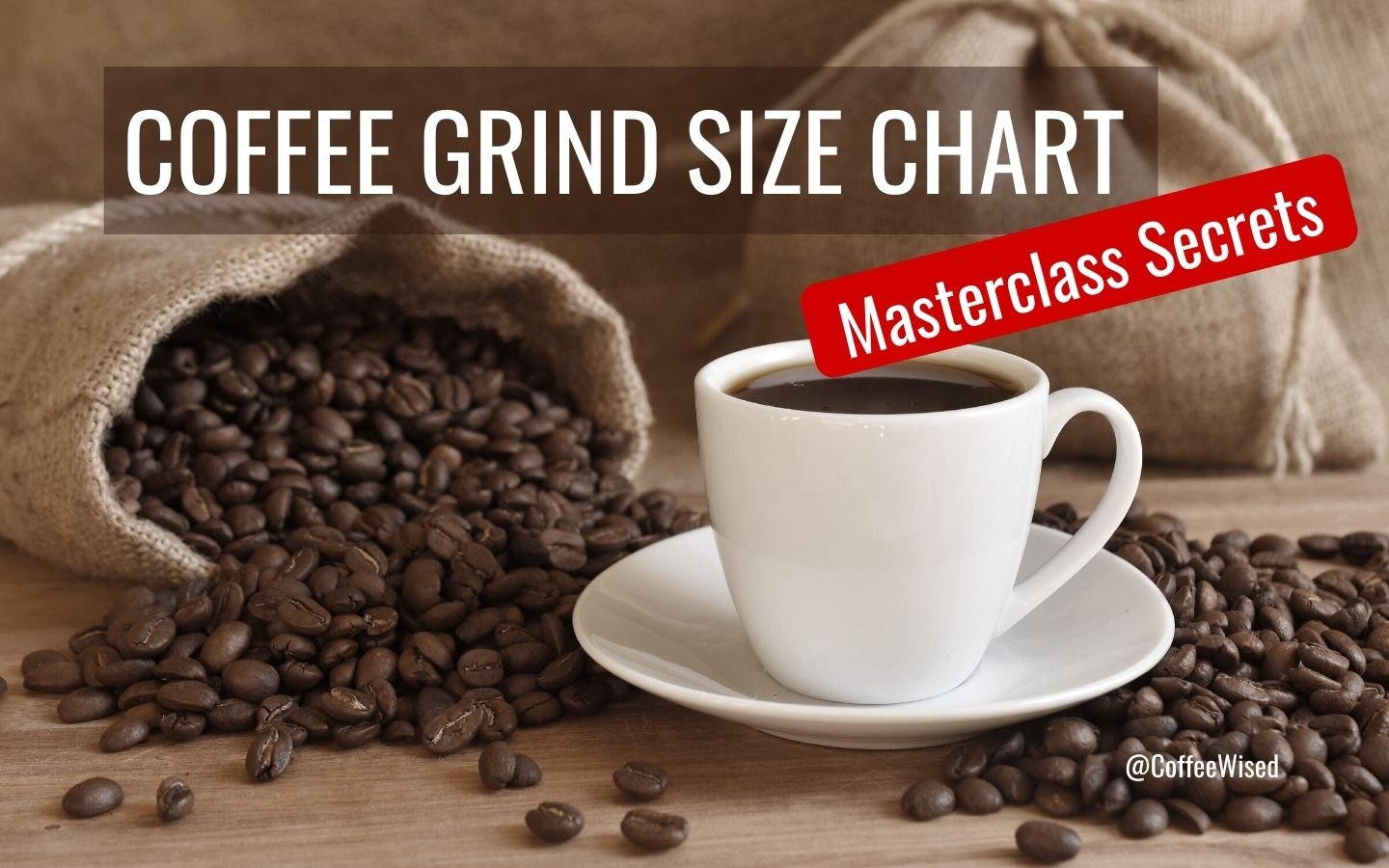Coffee Grind Size Chart: Masterclass Secrets
Coffee grind size chart attached next to your coffee grinder is a blessing. I took a masterclass about coffee grind size, and it totally changed my coffee experience. Of course, God created coffee on the eighth day so that we can enjoy rest of the seven days, but if your coffee tastes bad, none of the seven days can feel good too.
400 million cups – yes! Americans drink, on average, 400 million cups coffee every day. This study explains in detail about how habitual coffee drinkers display a distinct pattern of brain functional connectivity.
So, what do you need for perfectly ground coffee? The best coffee grinder? NOPE!
You only need to understand the coffee grind size chart, right grinders for different types of coffee grinds, and the correct brewing technique.
This is the ONLY Coffee Grind Size Chart You Would Ever Need
The masterclass on coffee grind chart taught many secrets that baristas use, and also explained which coffee grind size is good for different types of brewing methods. In this blog, I will share all the masterclass secrets that I have been taught, PLUS some more tips and tricks from my personal experience.
Why Coffee Grind Size Matters – About Extraction Metrics and Mechanics
You can use any coffee grind size chart and method to extract coffee, but it might not be your best cup of coffee. To make your perfect cup of coffee, you need to understand a little bit of science, even if you hated it in school.
· Surface Area or Grind Size
When you pour hot water over coffee, it enters each coffee particle to extract the flavors. Think of it like an onion (but please don’t cry). Onions are opened layer by layer. Similarly, when you pour hot water over coffee, it enters the coffee from the outer layer into the inner layers.
If you are using a smaller coffee grind size like fine grind, hot water will get more surface area to extract the flavors. For coarse grind, water will need more time to reach the heart of each coffee particle and extract flavor from all layers of coffee. For example, coarse grind is the most suitable French press grind size.
· Resistance
Resistance of coffee means the area it provides for the water to flow through it. Here is a little fun experiment to understand this. Fill one big glass with rocks and one big glass with sand. The rocks will allow more water to pass through because there are big gaps between rocks. The sand will allow less water to pass through because of the smaller gaps between sand particles. Similarly, coarsely ground coffee allows more water to pass through, and has lower resistance, while fine grind has a higher resistance to water.
Coffee resistance is important to calculate your brewing time. If you are using coarse grind, you will need to brew it for longer, while for fine grind, you will need to brew it for lesser time.
· Pressure
One of the most important metrics, often ignored too, is pressure. This means how much pressure is inserted to extract coffee. The more pressure you insert, the more coffee is extracted. This is why, coffee extracted with French Press is different from coffee extract with commercial espresso machine, even if you use the same French press grind size as of commercial espresso machine. Commercial espresso machines use different coffee grind size for each brew.

Blade or Burr Grinder – Which One to Choose?
Coffee bean grinders come in two types of grinders. One is blade and the other is burr grinder. You can create your own coffee grind size chart if you understand the types of grinders.
Burr grinder vs blade grinder is one of the most common concerns when it comes to getting perfect grind size. Many people prefer buying blade grinders because they are cheaper in cost, and well, you have to just grind your coffee, right?
You might think otherwise.
How does a Blade Grinder Work?
Blade grinder has a spinning blade that grinds coffee beans like a chopper chops the vegetables. This means that the coffee beans will pass through the blade and will be cut into pieces. If a coffee bean passes more rounds than others, it will be ground into very fine powder. However, if a coffee bean passes fewer rounds, it will be left coarsely ground. Sometimes, you might clearly see large chunks of coffee with a blade grinder.
How Does a Burr Grinder Work?
Burr grinder, or burr mill, has two rough discs. Burr grinder’s mechanism is similar to that of a pepper mill. You can set your burr grinder to your desired setting, like fine grind or coarse grind. The beans pass between the burr discs for a consistent grind throughout. This way, you get better control over the brewing time and flavor of the coffee. Consistent grind size gives you a richer flavor for your coffee palate. You can also make your own coffee recipes by better controlling the flavor of coffee with just a burr grinder.
Why is Consistent Coffee Grind Size Important?
Consistency in coffee grind size gives you maximum control over the flavor and texture of your morning cup. When you pour hot water over coffee, the water passes through each coffee particle to extract flavor.
- If you have coarse grind, you need slow brew methods to extract maximum flavor.
- If you have fine grind, you need fast brewing methods to extract maximum flavor.
- However, if you have inconsistent grind, that is a mix of fine and coarse grind, you will get poorly extracted coffee – and a bad cup of coffee.
Is a burr grinder really worth it?
My answer is, yes! The more consistent your grind, the more control you have over the flavor of your coffee. Burr grinder gives you equal consistency throughout. You can choose fine grind or coarse grind, depending on which brewing method you are using today.
Blade grinders are faster than burr grinders. If you have just started upscaling your coffee game, then blade grinder is a good choice. They are cheaper, faster, and easier to handle.
Are you still concerned about burr grinder vs blade grinder? My big vote is with burr grinder. Grinding your own coffee is addictive, and burr grinder is a lifetime investment.
How Do You Know Your Coffee is Poorly Extracted? – About Taste Metrics
Coffee taste depends on how perfectly it has been extracted. Poorly extracted coffee is either under-extracted or over-extracted even if you follow the coffee grind size chart exactly.
- Under-extracted coffee is mostly a result of less extraction with coarse grind coffee.
- Over-extracted coffee is mostly a result of too much extraction with fine grind coffee.
Under-extracted coffee tastes sour, salty, or acidic. The right way to fix it is:
- Using finer grind
- Lowering water temperature before pouring over coffee
- Increasing brew time
Over-extracted coffee tastes bitter and lacks the rich coffee flavor. It can be fixed by:
- Decreasing the brew time
- Increasing water temperature
- Using coarse grind
Pick any of the solutions and experiment with them, making one change at a time, until you get your perfect cup of coffee.


Types of Coffee Grinds and Their Best Uses
The 7 types of coffee grind size define the flavor, texture, and aroma of your cup.
Coffee Grind Size 1: Extra Coarse Grind
Set your burr grinder on the highest setting to get extra coarse grind. Coffee beans are roughly crushed in coarse grind, and you can almost see the shape of the original beans.
Extra coarse ground coffee for cold brew or cowboy-style coffee will give you a lifetime experience to remember.
Coffee Grind Size 2: Coarse Grind
Coarse grind is almost similar to the texture of sea salt or Kosher salt. The chunks are large and have consistent size if done in burr grinder.
If you love French Press coffee every morning like me, then coarse grind is your best bet. Coarse grind is perfect for percolators too. This is why I also call it percolator coffee grind. When using coarse ground coffee for cold brew, you can reduce the refrigerator time to 18 hours.
Coffee Grind Size 3: Medium-Coarse Grind
Medium-coarse grind is a little bigger than pre-ground coffee, but smaller than coarse grind. Its texture is like sand with bigger particles.
Medium-coarse grind is best used for Chemex and Café Solo-type specialty brewers.
Coffee Grind Size 4: Medium Grind
The store-bought pre-ground coffee falls in medium grind on coffee grind size chart. Its texture is like smooth sand with smaller particles.
Medium grind is best used for drip coffee makers. You can also use it in AeroPress with a maximum of 3 minutes brewing time.
Coffee Grind Size 5: Medium-Fine Grind
Medium-fine grind is smoother than medium grind. Its texture is like smooth sand, in fact, a bit smoother than sand.
If you love cone-shaped pour overs and vacuum brewers, then medium-fine grind will make you a perfect cup of coffee.
Coffee Grind Size 6: Fine Grind
Fine grind is a bit thicker than powder. When you buy pre-ground espresso from the store, it is the fine grind. This is why the fine grind is also known as espresso grind.
If you love espresso, then fine grind must be on your shelf all the time. You can also use fine grind in AeroPress with a maximum of 2 minutes brewing time.
Coffee Grind Size 7: Extra Fine Grind
Extra fine grind is exactly like the flour we use for baking. It is like a fine powder, mostly used for a quick cup of coffee.
If you are a Turkish coffee lover, then extra fine grind will give you the best cup of coffee. I have not experimented extra fine grind for any other coffee, but I believe it would work in AeroPress with a maximum one-minute brewing time.
Here is how different types of coffee grind sizes look.

Winter or Summer, Masterclass Rules to Remember: Coffee Grind Size
- The coarser your grind is, the slowly water will extract flavor from the coffee. When you pour water on the coffee grounds, it needs to pick up the flavor. If you are using a brewing method that involves longer extraction time, then you need coarse grind.
- Methods like French Press and cold brew, in which water to coffee exposure time is longer, you need coarse grind.
- Then there are methods that involve water and coffee extraction time for a few seconds, up to a minute. They need medium to medium-fine grinds.
- Methods that involve fast extraction need fine grind. For fine coffee grind size, espresso, Moka Pot and Turkish coffee type methods are most suitable.
FAQs
Are you following the coffee grind size chart exactly and still getting a not-so-perfect cup of coffee? Here are the most common causes and their solutions.
My coffee tastes watery, is it a grind problem?
Using coarse grind and brewing for short time, or using a very small amount of coffee makes watery coffee. To fix it, you need to use medium-fine grind for the same brewing time and water temperature. If using coarse grind, increase water temperature and brew a little longer.
My coffee tastes bitter. What type of grind do I need to fix it?
Bitter coffee is a result of over-extracted coffee. To fix your bitter coffee, use a thicker grind than what you are currently using. For example, use medium-coarse grind instead of medium-fine grind. Also, decrease brewing time by 30 seconds.
My coffee tastes bad, how do I fix it?
A bad-tasting coffee is either over-extracted or under-extracted coffee. If it is under-extracted coffee, then you need to use a finer grind, increase water temperature, and increase brew time by 30 seconds. If it is over-extracted coffee, then use a coarse grind, decrease water temperature, and decrease brew time by 15 seconds.
Can you grind hot coffee beans?
Yes, you can. Hot coffee beans will release the oils in coffee during the grinding process and give you the perfect light roast flavor. However, it’s best to use hot ground coffee beans within 3 days. For hot grinding, heat coffee in the microwave for 1 minute, grind immediately, and temper in the refrigerator for 1 hour.
Can I use coarse ground coffee for cold brew?
Extra coarse grind for cold brew is my personal favorite. As the coffee will steep in the fridge for 24 hours, you will extract maximum flavor from your coarse grind, and get rich, Starbucks-style cold brew coffee. Strained cold brew coffee can be stored in the fridge for up to 2 weeks.
Coarse vs fine ground coffee, which one to choose?
It depends on the brew type. Coarse grinds are better for brew methods that have increased coffee-water contact time, such as French Press and cold brew. Fine grind is suitable for brew methods like espresso, pour-over, AeroPress, Moka Pot, etc.
What is the optimal Moka pot grind size?
The best grind size for a Moka Pot is medium-fine or fine grind. The grind size should be a little finer than the grind size you use for drip coffee. Espresso grind does not give optimal results for a Moka Pot.
What is the best pour over grind?
The best pour-over grind size is the medium-coarse grind. It is slightly smoother than the grind used for French Press. Using a burr grinder will help achieve a consistent medium-coarse grind for a perfect cup of coffee.
Is v60 grind size similar to chemex grind size?
V60 is less forgiving, and prefers a perfect medium-grind only, done with #3 setting on Burr grinder. The best grind size for Chemex is the medium-coarse grind. However, even if your grind is a little finer, the flavor of the coffee will not change a lot with Chemex.
Why should I use different grinds of coffee?
Different brewing methods require different grinds of coffee for perfect flavor. It depends on the coffee-water contact time, brewing time, surface area, resistance, and pressure applied to extract coffee. Fine grind for espresso, medium-coarse grind for V60, Chemex, and Drip coffee, coarse grind for pour-over, etc.
What is espresso grind size?
Espresso grind size is the fine grind. Its chunks are a little bigger than powder or cake flour, but with a smooth texture. It is also used for AeroPress and Moka Pot. For Turkish coffee, you need a very fine grind, that is thinner than espresso grind, and has a texture like powder.
What is the best grind for drip coffee?
The best grind for drip coffee is medium grind. It is the same grind you get from pre-ground store-bought coffee. The texture is like sand with more definition in each particle.
My coffee tastes sour, how do I fix it?
Sour-tasting coffee, or acidic coffee, is under-extracted coffee. To fix it, increase the amount and temperature of the water, brew for 30-60 seconds long, and check the taste. If it is still sour, then add a little more coffee for the next brew.
How long to grind coffee beans?
- Using a blade grinder, a coarse grind requires around 8-10 seconds of grinding time in blade grinder.
- Fine grind requires around 30 seconds of grinding.
- For medium-coarse grind, you need short burst of grinding for 10-15 seconds.
- Burr grinder has its settings that give you consistent grind without worrying about time.
My coffee grinder settings are difficult. What setting should a coffee grinder be on?
It depends on what type of grind you want. A burr grinder gives perfect espresso grind on #1 setting, while Baratza Encore gives perfect espresso grind on #5. Our coffee grind size chart has settings identified for each grind size. You can download and print it.
How do I adjust grind on my grinder?
Decide an adjustment and set your grinder on it. Then run the grinder for 10 seconds. Discard these coffee beans, because the grinder still has an old setting. You can use these coffee beans as fertilizer in the garden. Now add another batch of coffee beans and grind them to your required size.
What do numbers mean on a coffee grinder?
Numbers are the setting labels on coffee grinds. Each label gives a different grind size. However, each coffee grinder has its own labels. It is best to understand the labels from the manual. Otherwise, have a look at my no-nonsense coffee grind table to know the numbers on your coffee grinder.
What is the best size to grind coffee?
It depends on the brew method you are using. A coarse grind is suitable for brew types with longer extraction time, such as cold brew, and a fine grind is suitable for brew methods with shorter extraction time, such as espresso. Each coffee grind size can give you a perfect cup of coffee if done right.
What is the best grind for drip coffee?
The best grind for drip coffee is a medium-coarse grind. It is the similar grind that you get in pre-ground store-bought coffee.
Does finer grind make stronger coffee?
A finer grind does not mean you will have stronger coffee. For a strong cup of coffee, you need the correct grind for your required brew method. My go-to technique for a strong cup of coffee is a coarse grind for French Press.
Why do I grind my own coffee when I can buy pre-ground coffee?
Ground coffee starts releasing its oils when exposed to air. It is called the oxidation method, which can leave a metallic aftertaste in your coffee. Grinding your own coffee gives you better control over the flavor and freshness of coffee by keeping coffee grind size in check.
What is the best French Press grind size?
The best French Press grind size is a coarse grind. It is a little thinner than extra coarse grind and has a consistent texture. To get a coarse grind, run your burr grinder on the highest setting. If using a blade grinder, run your grinder in shots for 3-5 seconds only.
How coarse for French press?
Coarse grind, thicker than extra coarse but thinner than medium-coarse is most suitable for French Press. It has consistent but thick particles.
I cannot download my coffee extraction chart. How can you help?
If you are experiencing difficulty in downloading the coffee extraction chart, you can send us an email at hello@thecoffeewised.com. Or you can send us a direct message at the form given on Home Page.
Which is the smallest coffee grinder?
Brim’s grinder is considered the smallest coffee grinder. It has 9 grind sizes and can fill up to 30 grams of coffee. You can grind your coffee from coarse grind for French Press to fine grind for Espresso in a Brim’s grinder.
How is home grinded coffee different from store-bought pre-ground coffee?
Store-bought pre-ground coffee has chances of oxidation once the package is opened. It affects the freshness and flavor of your otherwise perfect cup of coffee. Also, the texture of home-ground coffee can be controlled as per your choice, and if stored correctly, you can enjoy a fresh cup of coffee for the entire week without worrying about the coffee grind size.
You have now attended the coffee grind masterclass with me. I highly suggest you download the pictures, infographic, and other dowloadables here, print them, and stick them on your coffee bar. It surely will change your entire coffee experience, just like it did for me.
Have any questions? Just drop a comment and I will reply at the earliest!

2 thoughts on “Coffee Grind Size Chart: Masterclass Secrets”